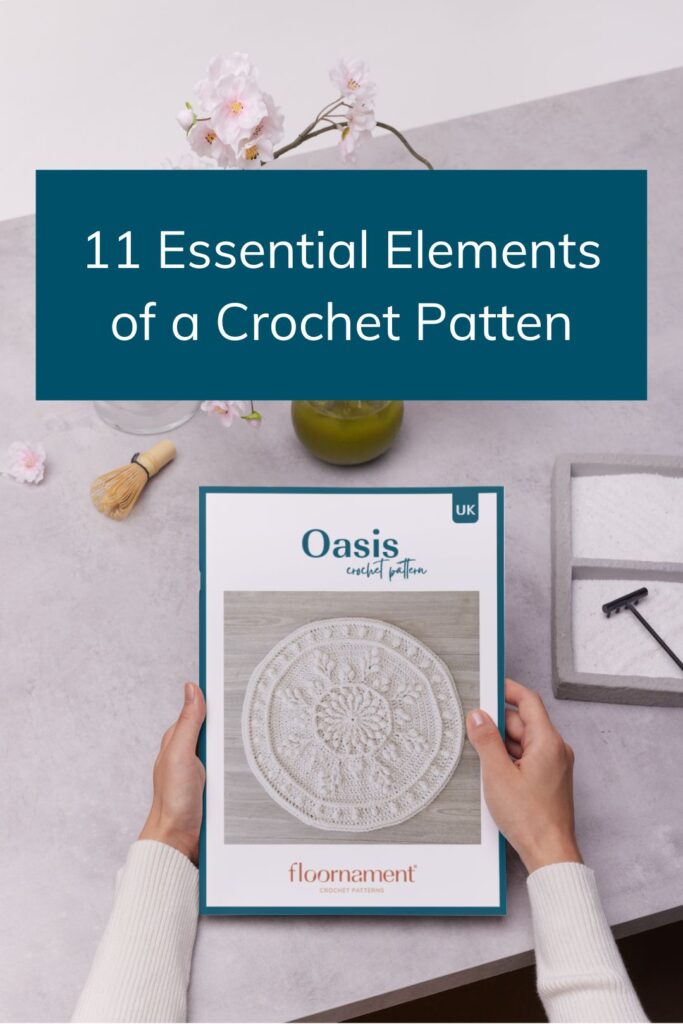
Discover the essential elements of a crochet pattern. From written instructions to stitch abbreviations, charts, and more, learn what makes up a comprehensive crochet pattern. Explore how each element contributes to creating beautiful crocheted designs.
A crochet pattern name not only makes it easier to identify but also helps distinguish one pattern from another, especially in the vast world of crochet where countless designs are available.
When a pattern has a memorable name, crocheters can easily refer to it in conversations, searches, or when recommending it to others.

Naming a pattern can add a personal touch for the designer, allowing the designer to infuse their creativity and personality into their work. A well-chosen name can evoke a certain mood, theme, or aesthetic associated with the project or brand.
Like any form of art or creative endeavor, crochet pattern design is a skill that deserves recognition. Including the designer’s name (either personal or business) gives credit where it’s due and acknowledges their expertise and effort in creating the pattern. It helps to establish ownership and protect their intellectual property rights. This recognition is important for both the designer and the crafting community as a whole.
Crocheters often develop preferences for certain designers based on their style, level of detail, and overall quality of patterns. By including the designer’s name, crocheters can easily identify patterns they trust and enjoy, leading to a sense of reliability and consistency. This helps build trust between the designer and their audience, fostering a loyal following over time.
Crochet patterns cater to a diverse audience with varying levels of experience and familiarity with crochet terminology. By specifying which stitch terms are used in the pattern (either UK or US), designers ensure that crocheters understand exactly which stitches to use and how to execute them.
For beginner crocheters, understanding crochet terminology is an essential part of the learning process. By including stitch terms in their patterns, designers contribute to the education of new crocheters, helping them become more proficient in the craft.
A photo provides crocheters with a clear visual reference of what the finished project should look like. This is especially helpful for beginners who may be unfamiliar with interpreting written instructions or stitch diagrams. Seeing the final outcome can help them understand the goal they’re working towards.
Some crochet patterns do not include a level of difficulty. A photo of the finished project can help crocheters gauge the difficulty of the design and help them determine if the design suit their level of crochet experience.
A well-styled and visually appealing photo can inspire crocheters to take on the project. It allows them to envision how the finished piece will look in real life, sparking excitement and motivation to pick up their hooks and get started.
Different yarn types, hook sizes, and notions can greatly affect the final outcome of a crochet project. By providing a list of supplies, the pattern ensures that crocheters have all the necessary materials to achieve the desired result.

The choice of yarn colour and texture can significantly impact the appearance and feel of the finished project. By specifying the exact brand, colour, and weight of yarn used in the pattern, designers help crocheters replicate the original design.
Providing finished measurements ensures that crocheters can accurately gauge the size of the final project. This helps prevent surprises and disappointment when the finished piece turns out smaller or larger than expected.
For wearable items such as sweaters, hats, and gloves, knowing the finished measurements is essential for achieving the right fit. Crocheters can compare the measurements to their own body or the body of the intended recipient to ensure a comfortable and flattering fit.
Crochet patterns should provide finished measurements for the project. However, the actual size of the finished piece can vary greatly depending on the tension of the crocheter. By providing gauge information, the designer ensures that crocheters can achieve the intended size and shape of the project.

Gauge is often given for a sample swatch that results in a 10 x 10 cm (4 x 4 in) square or may be given at certain parts of the project such as after a specific round or row.
Crocheters often like to substitute yarns based on availability, budget, or personal preference. Gauge allows crocheters to match the designer’s tension even if they’re using a different yarn weight or brand.
Gauge also helps crocheters estimate how much yarn they will need for the project. If their tension is significantly different from the designer’s, they may need more or less yarn to complete the project.
Crochet patterns can be quite detailed, and using abbreviations helps to condense the instructions, making them more concise and easier to read. This is particularly important for complex patterns with multiple steps.
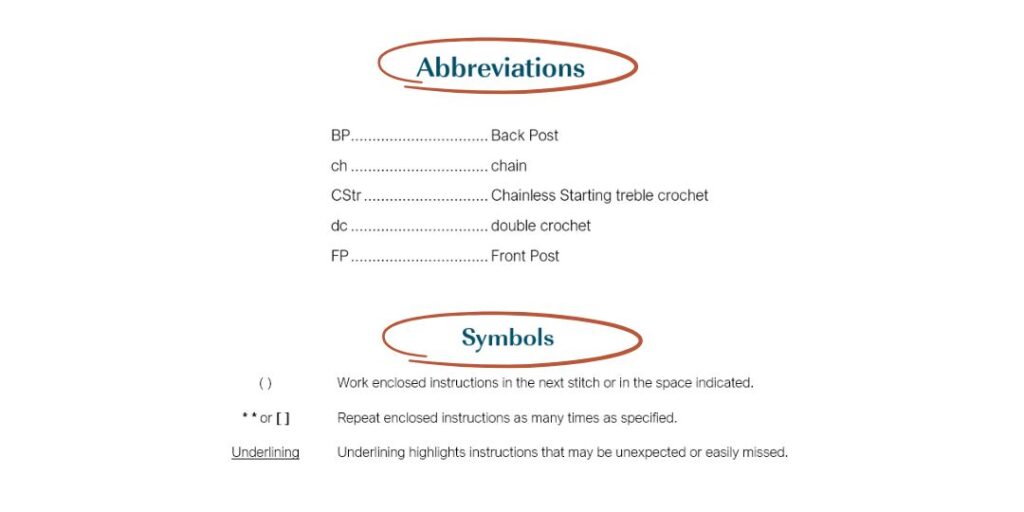
Having a list of abbreviations and symbols helps the crocheter to quickly and easily interpret the stitches, terms and symbols used in the pattern instructions. An abbreviation key serves as a handy reference guide. If a crocheter encounters an unfamiliar abbreviation, they can quickly consult the key to understand its meaning without interrupting their workflow.
The Craft Yarn Council has a Crochet Abbreviations Master List for US and UK crochet abbreviations including stitch names and crochet terms.
The notes section might include additional clarifications or tips that can help the crocheter understand specific steps or techniques better. This could include information on abbreviations used in the pattern, what does not count as a stitch or how to read the pattern.
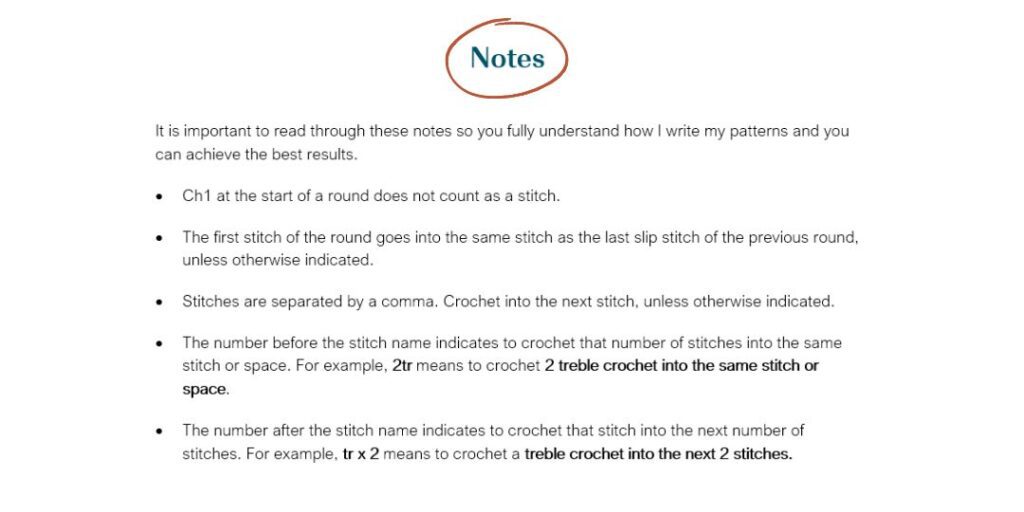
Sometimes, crocheters may want to modify the pattern to suit their preferences or needs. The notes section might suggest possible modifications or provide guidance on how to adjust the pattern for different sizes, yarn weights, or styles.
The heart of a crochet pattern lies in its written instructions. These instructions serve as the core of the pattern, providing a detailed roadmap for crafting the design, step by step. Essentially, they’re the essence of the pattern, guiding crocheters through each stitch and technique needed to bring the design to life.

Pattern instructions should always include a row or round number, the written instructions and the stitch count for each row or round.
Pattern instructions should be easy to read and follow, use consistent and standardized crochet stitches and terms, and ensure that the crocheter can replicate the design in the project photo.
Some pattern instructions include photos, images, diagrams or charts to help the crocheter confidently achieve the desired results.
Sometimes, even the most well-written patterns can be confusing or ambiguous to some crocheters. The contact section allows users to reach out to the designer or publisher for clarification or to ask questions about specific instructions. Contact is most commonly through email or social media messaging.

Crocheters may have suggestions for improvements or feedback on the pattern. Providing a contact section allows them to easily share their thoughts with the designer or publisher, which can be valuable for future revisions or designs.
In addition to the written instructions, crochet patterns often contain supplementary elements that aren’t strictly necessary but are included by some designers to enhance the user experience. These may include visual aids such as charts or diagrams, which offer alternative ways to understand the pattern and can be particularly helpful for those who prefer visual learning.
Many designers chose to include the level of difficulty in their crochet patterns. Difficulty levels provide valuable guidance for crafters, especially beginners, in selecting projects that match their skill level. This helps them avoid frustration or feeling overwhelmed by attempting projects that may be too advanced for their current abilities.
Some designers choose not to include a difficulty level as they can be subjective and vary from person to person based on their skill level, experience, and familiarity with different techniques. What one person finds easy, another may find challenging. Designers may prefer not to assign a specific difficulty level to avoid potentially misleading or frustrating users.
Some crochet patterns may also include a yarn substitutions section of the crochet pattern. If the listed yarn is discontinued, too expensive or not available in a suitable colour, a yarn substitution section will help crocheters choose an appropriate alternative that is recommended by the designer.
As a crochet rug designer, I recognise that the cord listed in my patterns is not always within the crocheters financial budget so I have a list of 20+ yarn substitutions for every rug that I design.
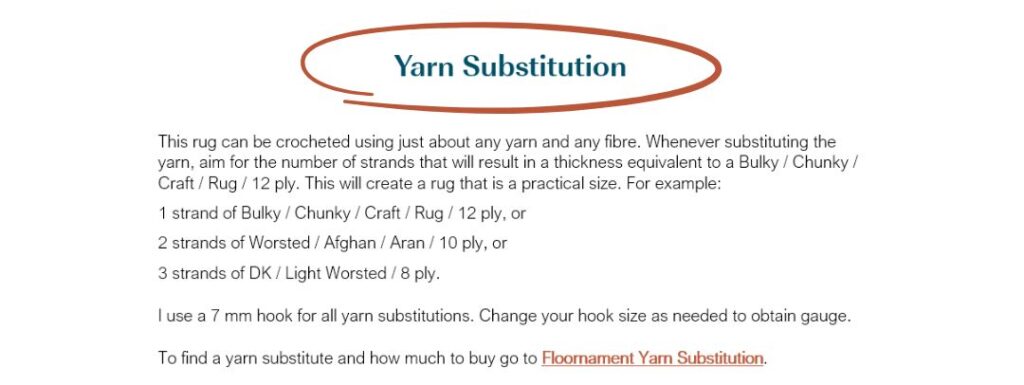
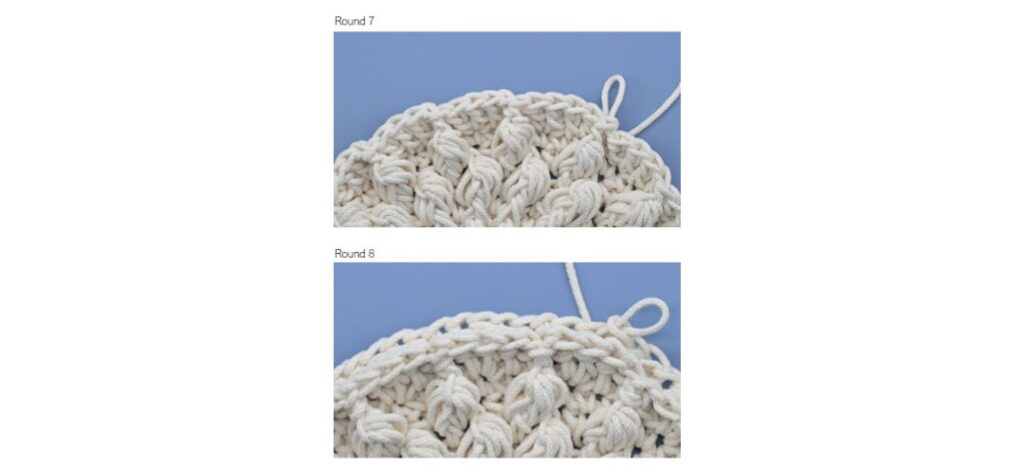
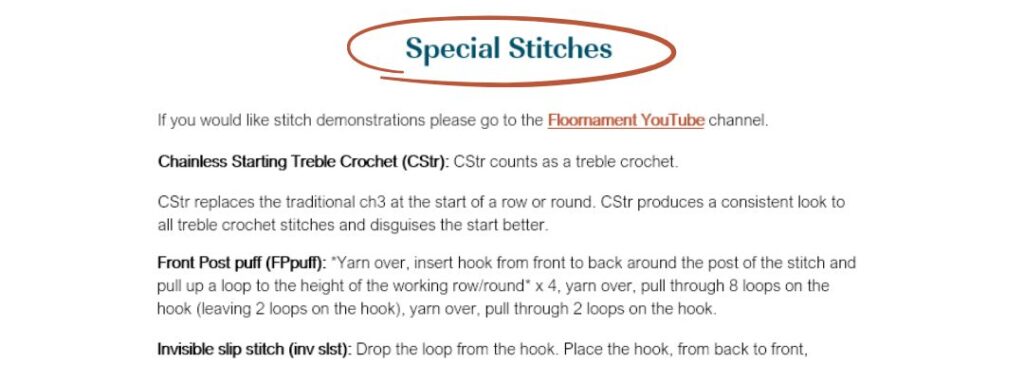

No. The 11 essential elements provide a comprehensive framework for a crochet pattern. If 1 or more of the elements is not in the pattern, there may still be enough information for you to complete the design.
If you are a crocheter who wants to start writing patterns, I highly recommend using all essential elements in your patterns. This will give you a comprehensive pattern that covers all the necessary information someone will need to complete your design.
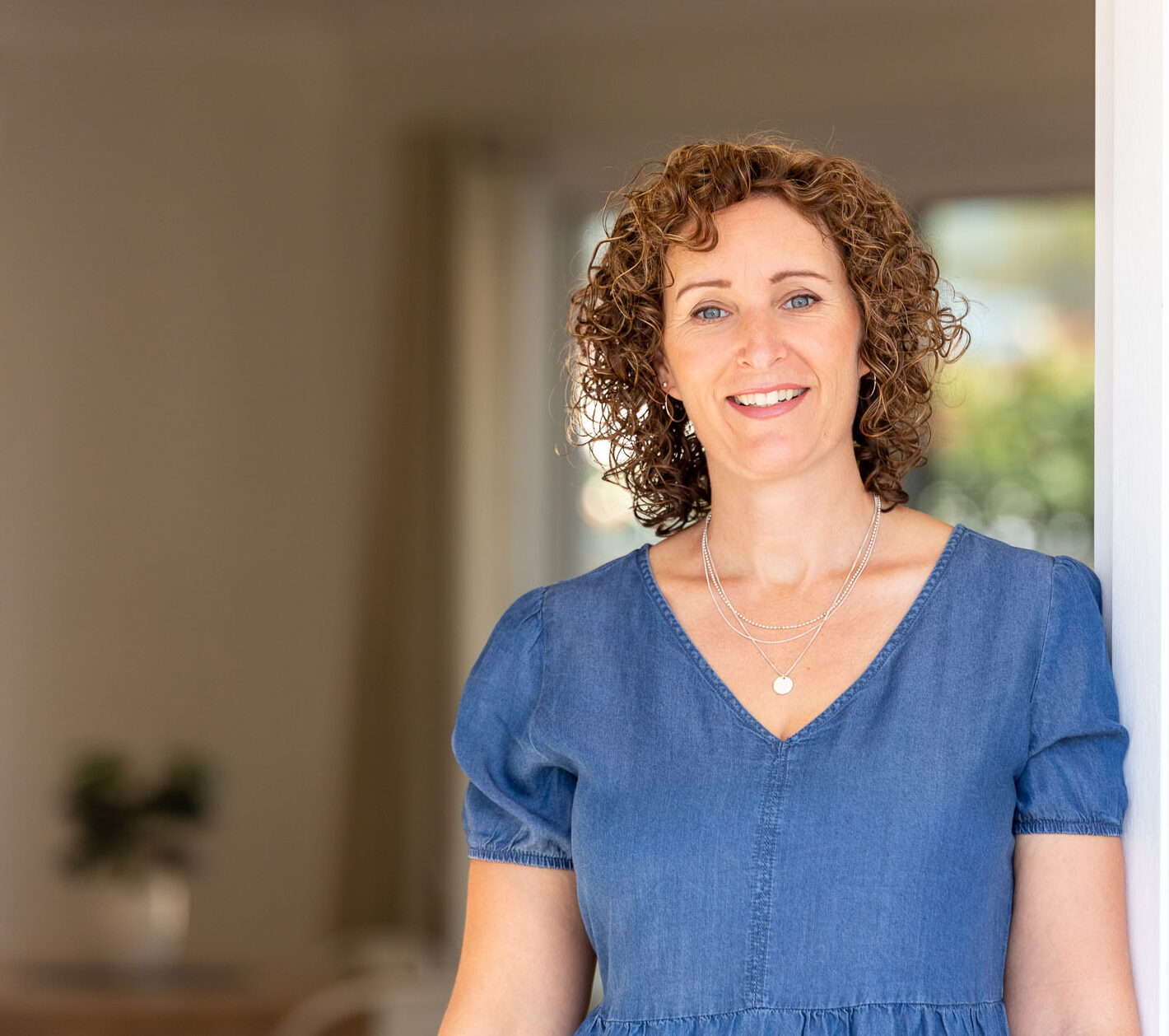
Hi, I’m Andrea!
I am a wife and mum of 6 kids.
I love to camp, eat chocolate and I’m addicted to crochet!
Floornament was born out of a love of crochet and a desire to create crochet patterns so that others can decorate their home with beautiful crochet floor rugs.
FOLLOW ME
Take me to…